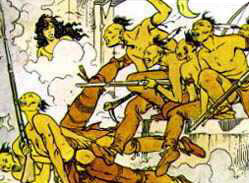Really, you can get away with portraying aliens (e.g., War of the Worlds, Alien, Predator), animals (e.g., The Birds, Willard, Arachnophobia), or machines (e.g., Terminator, Berserker, the original Battlestar Galactica's Cylons) as fierce, unrelenting fighters and killers. But human beings? No. If Jake La Motta (Raging Bull), the Punisher, or Hannibal Lecter has more than one side, everybody does.
Does "fierce" define a warrior?
If you think warriors are defined by their ferocity, look at any good war movie about American soldiers. Sure, the soldiers are fierce when they have to fight. But they also exhibit a range of other traits: curiosity, generosity, eagerness, skepticism, anger, cowardice. Especially strong are the emotions of doubt and fear, because--in case you haven't heard--war is hell. Real soldiers don't want to fight fiercely because they could get shot or blown to pieces.
Maybe traditional Indians looked forward to fighting and killing, though I wouldn't bet on it. The whole idea of "counting coup" was to prove one's bravery without killing one's foe. I.e., by using skill, not savage ferocity.
In any case, modern people generally don't look forward to fighting and killing. That includes modern Indians such as Twilight's werewolves. Any movie that portrays Indians as primarily fierce is stereotypical.
For more on the subject, see Are Good Native Werewolves Okay? and Quileute Werewolves in Twilight.
Below: The first Indians encountered by the English in the 1600s and Indians encountered in the movies today. Two eras of Indians as predatory, wolfish savages.
"Crush! Kill! Destroy! We're Indians/robots/aliens!"



No comments:
Post a Comment